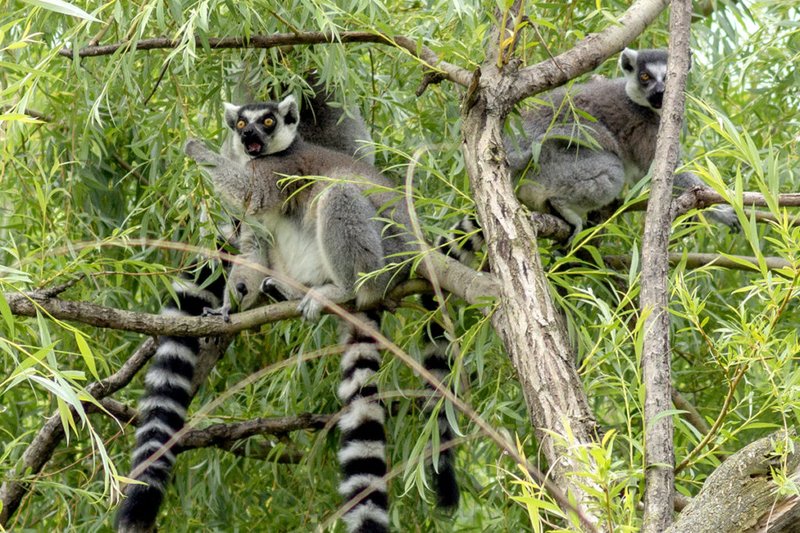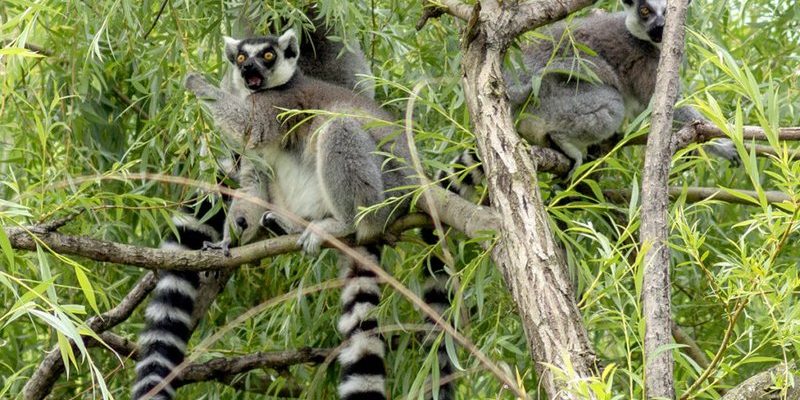
Ring-tailed lemurs are not just cute; they’re also an important part of Madagascar’s ecosystem. They help disperse seeds and maintain the health of their habitats. Understanding where they live and how they thrive can give us insight into the delicate balance of this extraordinary environment. So, cozy up with a cup of coffee, and let’s dive into the world of ring-tailed lemurs, exploring their habitats and distribution like old friends sharing stories.
Overview of Ring-Tailed Lemurs
Before we delve into where ring-tailed lemurs live, let’s get to know them a bit better. These lemurs are unique to Madagascar and recognized by their signature tails, which have black and white stripes. They are social creatures, often found in groups called troops, which can include anywhere from 5 to 30 members! Imagine a bunch of playful cousins hanging out together.
Ring-tailed lemurs are primarily herbivores, munching on leaves, fruits, and flowers. They have a keen sense of smell and use it to communicate with each other, marking their territory with strong scents. It’s a whole social network among those fluffy friends. You might be wondering how they manage to thrive in such a varied landscape—well, the answer lies in their adaptability and the specific habitats they choose.
Natural Habitat of Ring-Tailed Lemurs
Ring-tailed lemurs have a fascinating range of habitats—from dry deciduous forests to humid rainforests and even scrubland. They thrive mainly in subtropical and tropical forests where they can easily find food and shelter. These lush landscapes provide plenty of leaves and fruits for them to munch on, along with places to play and socialize.
Interestingly, ring-tailed lemurs prefer areas that are not too dense. They often choose habitats with a mix of trees and open spaces. This allows them to move around easily while keeping an eye out for potential predators. Think of it as choosing a balanced diet: they need a variety of food, but they also want comfort and safety.
Regional Distribution in Madagascar
When it comes to distribution, ring-tailed lemurs are found primarily in the southern regions of Madagascar. You can spot them in several national parks and reserves, such as Andringitra National Park and Berenty Reserve. These areas are crucial for their survival, as they protect their natural habitat from destruction and offer opportunities for research and conservation.
If you look at a map, you’ll see that these lemurs have a pretty distinct territory. They typically inhabit the dry, spiny forests of the southwest and the lush forest areas in the southeast. Climate variations influence their distribution, as they tend to live where the weather is just right for their needs. It’s like having your favorite ice cream flavor available only in certain shops—geography matters!
Impact of Habitat Loss on Ring-Tailed Lemurs
Sadly, the survival of ring-tailed lemurs is under threat. Habitat loss due to deforestation, agriculture, and climate change is significant. Over the years, Madagascar has lost a substantial amount of its forest cover, and this poses a real danger to the ring-tailed lemurs. Without their natural habitat, they struggle to find food and safe places to live.
Imagine having to move out of your home because it’s being torn down; that’s what these lemurs are facing. Conservation efforts are crucial. Initiatives that focus on reforestation and creating protected areas can help restore their habitat and give them a fighting chance. Plus, educating locals on the importance of these primates can foster a sense of responsibility and connection to their environment.
Behavioral Adaptations to Their Environment
Ring-tailed lemurs are incredibly adaptable, which helps them thrive in various habitats. Their social structure allows them to work together when foraging for food or defending against predators. They often engage in activities that strengthen their bonds, like grooming each other. It’s like their version of a Netflix night, but with a lot more fur and a lot more fun!
Another fascinating aspect of their behavior is how they use their tails. These iconic striped tails aren’t just for looks; they help with communication and balance. When they greet each other or establish dominance, you’ll often see them waving their tails around. It’s a visual language that keeps their social groups in harmony.
The Role of Conservation in Protecting Their Habitat
As you can imagine, conserving the ring-tailed lemurs’ habitat is vital for their survival. Conservation organizations are actively working on multiple fronts—promoting sustainable agricultural practices, protecting existing forests, and engaging local communities in conservation efforts. It’s a collaborative endeavor, involving everyone from scientists to local villagers.
Protected areas, like national parks, play a key role in safeguarding these primates. They not only provide a safe haven for lemurs to live but also serve as natural laboratories for researchers to study their behavior and ecology. You might think of these parks as a big safety net, catching the lemurs when their natural habitat is at risk.
Future of Ring-Tailed Lemurs in Their Habitat
Looking ahead, the future of ring-tailed lemurs hangs in the balance. With continued efforts in conservation and education, there is hope. The involvement of local communities can lead to more sustainable practices that protect these beautiful creatures and their homes. It’s like planting seeds for a future where these lemurs can thrive alongside humans.
In the end, understanding where ring-tailed lemurs live and the challenges they face helps us appreciate their role in the ecosystem. Whether they’re lounging in trees or leaping through the underbrush, they are a vital part of Madagascar’s rich tapestry of life. Their survival is intertwined with the health of the forests, and protecting them means protecting the very essence of Madagascar.
In essence, rings-tailed lemurs are not just a species; they’re a symbol of Madagascar’s unique biodiversity. Their habitat is their lifeline, and the ongoing efforts to protect it will determine their fate and that of many other species that share their home. So next time you think of those adorable little creatures, remember the vital role they play in their ecosystem and the work being done to keep them safe.

